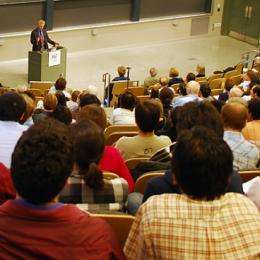Progress being made in stem-cell therapy, scientist says

For the past two decades, scientists have been trying to fulfill the promise that stem-cell therapy holds for treating diseases such Parkinson’s, Alzheimer’s and many others. Their ultimate goal is to be able to remove healthy cells from a patient, reprogram them to stem cells, and induce them to differentiate into the type of cells the patient needs to treat a disease.
“This scenario, which seemed like fantasy only a few years ago, is closer to reality,” Rudolf Jaenisch, professor of biology, said Tuesday at the annual James R. Killian Jr. Faculty Achievement Award Lecture. Established in 1971 as a tribute to MIT's 10th president, the Killian Award recognizes extraordinary professional accomplishment by an MIT faculty member.
Jaenisch, a founding member of the Whitehead Institute for Biomedical Research and a pioneer in transgenic mice, stem-cell biology, mammalian cloning and regenerative medicine, spoke Tuesday on his latest research focus: stem-cell reprogramming and its potential for treating human disease.
Stem cells, which are normally found only in embryos, have the potential to become any type of cell, an ability known as pluripotency. Scientists hope to take advantage of that to create new tissue to treat a range of diseases. For example, new brain cells could be grown for Parkinson’s patients, or new insulin-producing cells transplanted into diabetics.
In recent years, scientists have shown that body cells such as skin cells can also become pluripotent, through a process known as reprogramming.
One of the early keys to learning how to reprogram cells was discovering the importance of epigenomic control, said Jaenisch. Every cell in the body has the same DNA, but the DNA of different cell types is decorated with molecules that promote or prevent genes from being expressed. That annotation determines which parts of the cell’s genes are readable, much like adding punctuation and spaces allows people to read a piece of text, said Jaenisch.
In most adult cells, genes that allow pluripotency are blocked. However, in 2006, researchers at Kyoto University showed that pluripotency could be reactivated in rat cells by adding four genes, known as Oct4, Sox2, Klf4 and c-Myc. Those genes initiate a long and complex process that remodels the cell’s epigenome, allowing it to express all of the genes necessary for pluripotency.
At first, some people were skeptical of the results, but three other research groups, including Jaenisch’s, accomplished the same feat within a year. “It really electrified the field,” Jaenisch said.
Using reprogrammed body cells to treat disease would overcome one of the major hurdles to using embryonic stem cells, which is that embryonic cells would likely cause an immune reaction in the patient.
Three major challenges to using induced stem cells for therapy remain, said Jaenisch: First, scientists need to find a way to induce pluripotency without using viruses to carry the reprogramming genes. Efforts are underway to use proteins or drugs to reprogram cells, said Jaenisch.
A second obstacle is that integrating new genes into a cell’s DNA is much more difficult in humans than it is in mice. Jaenisch’s lab is working on a way to insert genes with enzymes called zinc-finger nucleases, which can be designed to snip human DNA in specific locations.
Lastly, researchers would like to find a way to generate induced pluripotent stem cells from human blood, as a replacement for the skin cells now used. This would make it easier to develop customized treatments for individual patients, Jaenisch said.
This story is republished courtesy of MIT News (web.mit.edu/newsoffice/), a popular site that covers news about MIT research, innovation and teaching.
Provided by Massachusetts Institute of Technology















